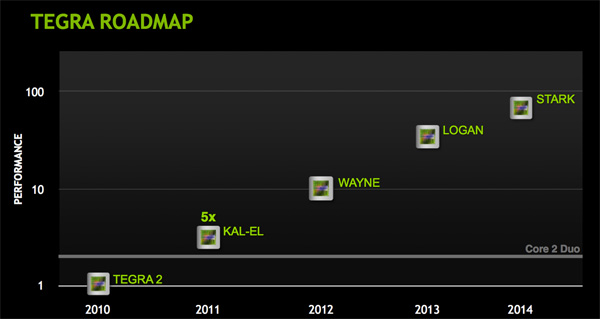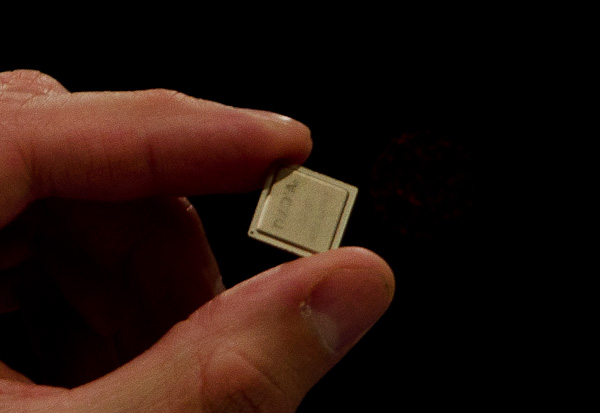NVIDIA's Kal-El Glowball Shows off Dynamic Lighting & Quad-Core Physics on a Tablet
by Anand Lal Shimpi on May 29, 2011 11:00 PM ESTI've warned both Qualcomm and TI that the danger they have to face in the SoC space going forward isn't just NVIDIA engineering, but NVIDIA marketing. Although too aggressive for my tastes at times, NVIDIA does know how to take a simple product release and turn it into an extremely polished technology launch. Even down to the materials NVIDIA shares with the press, to-date none of its competitors have built such pretty slides that make their way all over the web.
Obviously it's not just marketing with NVIDIA. After a rough start the Tegra 2 finally got real traction and has been the premier Android smartphone and tablet SoC since the beginning of the year. If you're buying an Android smartphone or tablet today, chances are the best option uses Tegra 2.
At MWC earlier this year NVIDIA announced its third applications processor, codenamed Kal-El. Kal-El will feature four ARM Cortex A9 cores with a shared 1MB L2 cache and MPE/NEON support (absent from Tegra 2). Kal-El will also fix the video decoder issue we've run into on Tegra 2 and should be able to play all high profile H.264 content with proper OS support. On top of all of that there's a faster GPU (12-core vs. 8-core plus higher throughput per core).

What does all of this have to do with NVIDIA's marketing? Today NVIDIA posted one of its famous tech demos running on a Kal-El reference platform to show off what's possible with the new SoC:
The video shows the output from a Honeycomb Kal-El development platform. In it you see techniques such as dynamic lighting and real-time physics. The latter uses all four of Kal-El's A9 cores, which you can see in action in the lower left of the video.
The Glowball demo is the perfect example of NVIDIA knowing how to execute on both the product and marketing sides when it comes to any major launch. Kal-El is still months away, but this is a great way to build excitement.
As always it's a pretty impressive tech demo but it's just that, a demo. As we've seen in the past, NVIDIA's tech demos are usually far more impressive than the actual titles we see released in the near term. After all, it's always easier to make a single scene look great vs. an entire game (not to mention that performance requirements go up as you add more dynamic characters in a given scene). But as a demo of what will be possible on a tablet by the end of the year, I can't complain.
NVIDIA said that Kal-El based devices are on track for release this holiday season. The original commitment was August 2011 but NVIDIA wouldn't be any more specific than to say that we may see some products launch before the holidays.

I suspect we may see more on Kal-El at Computex next week.












51 Comments
View All Comments
stephenbrooks - Monday, May 30, 2011 - link
Agreed. Core 2 Duo came out in 2006. NVIDIA beating its performance in 2011 is not exactly impressive.dagamer34 - Wednesday, June 1, 2011 - link
Mind you, it's running at 1/10th the power of a Core 2 Duo in your pocket, doesn't require any fans or a large battery either.Yeah, not that impressive.
Rumpelstiltstein - Monday, May 30, 2011 - link
can it run Crysis?stm1185 - Monday, May 30, 2011 - link
Like for instance would the 8 cores in Tegra 2 and the 12 Cores in Kal El be comparable in performance to the 480 cores in a GTX 570? 8 to 12 cores sounds like a good improvement, but then I think a GTX 570 has 480 cores, so at that level of progression its going to be a long time before these mobile parts match up.dragonsqrrl - Monday, May 30, 2011 - link
You're comparing apples and oranges there... the cores they're referring to in the Tegra series are completely different from the cores in Nvidia's desktop GPU's. You can't get an accurate idea of performance discrepancy through core-count comparisons, but none the less the gap is probably much wider then even your estimations would indicate.tipoo - Monday, May 30, 2011 - link
Nope. The cores are vastly different, the ones in mobile SoC's are far more simple and fixed-function in relation.logic_88 - Monday, May 30, 2011 - link
Ugh. With the Tegra 2's inability to decode high profile H264, I wish I could find a tablet that didn't use a Tegra 2.jalexoid - Monday, May 30, 2011 - link
TI should be shot for their hands off approach. I mean, they could benefit a lot if they actually pushed their OMAP4 SoCs...metafor - Monday, May 30, 2011 - link
Neither they, Qualcomm nor even some of the smaller players like ST-Ericson or Broadcomm are doing that badly. They get less press, yes but look at unit sales and design wins for at least phones. nVidia certainly has the biggest hype -- though their solutions are of course quite competitive -- but the end result hasn't been that they've swept the market. Whatever reason you may want to give that is up to you.I think people see the (extremely low-volume at the moment) Android tablet on-slaught, all based on Tegra 2 and they tend to think that translates into a huge takeover on nVidia's part.
In overall market volume, OMAP4, Snapdragon and to a lesser degree BCM and ST-Nova are still doing quite well.
Should other companies try to build more hype? Perhaps. I don't know that I care for nVidia's chest-thumping nor their attempt at fragmenting the Android market with "Tegra only" games. A small hack reveals competitive chips such Exynos can play them just fine.
Lucian Armasu - Monday, May 30, 2011 - link
Broadcom I think is very popular in Asia because they have cheaper SoC's. As for Qualcomm, actually Snapdragon had a LOT of hype in 2010 because it was in the first Android 2.1 phones and the first to get to 1 Ghz. Snapdragon was the standard in 2010 that all the other single core chips compared to. Also Qualcomm has that 600 Mhz chip that goes into low-end Android phones. Nvidia doesn't have that, but if they are smart they should be working on Cortex A5 chips, which are cheaper than ARM11 and almost as powerful as Cortex A8. Nvidia should try to conquer the low end, too, because I don't think the high-end will be enough if they want to be the market leader.